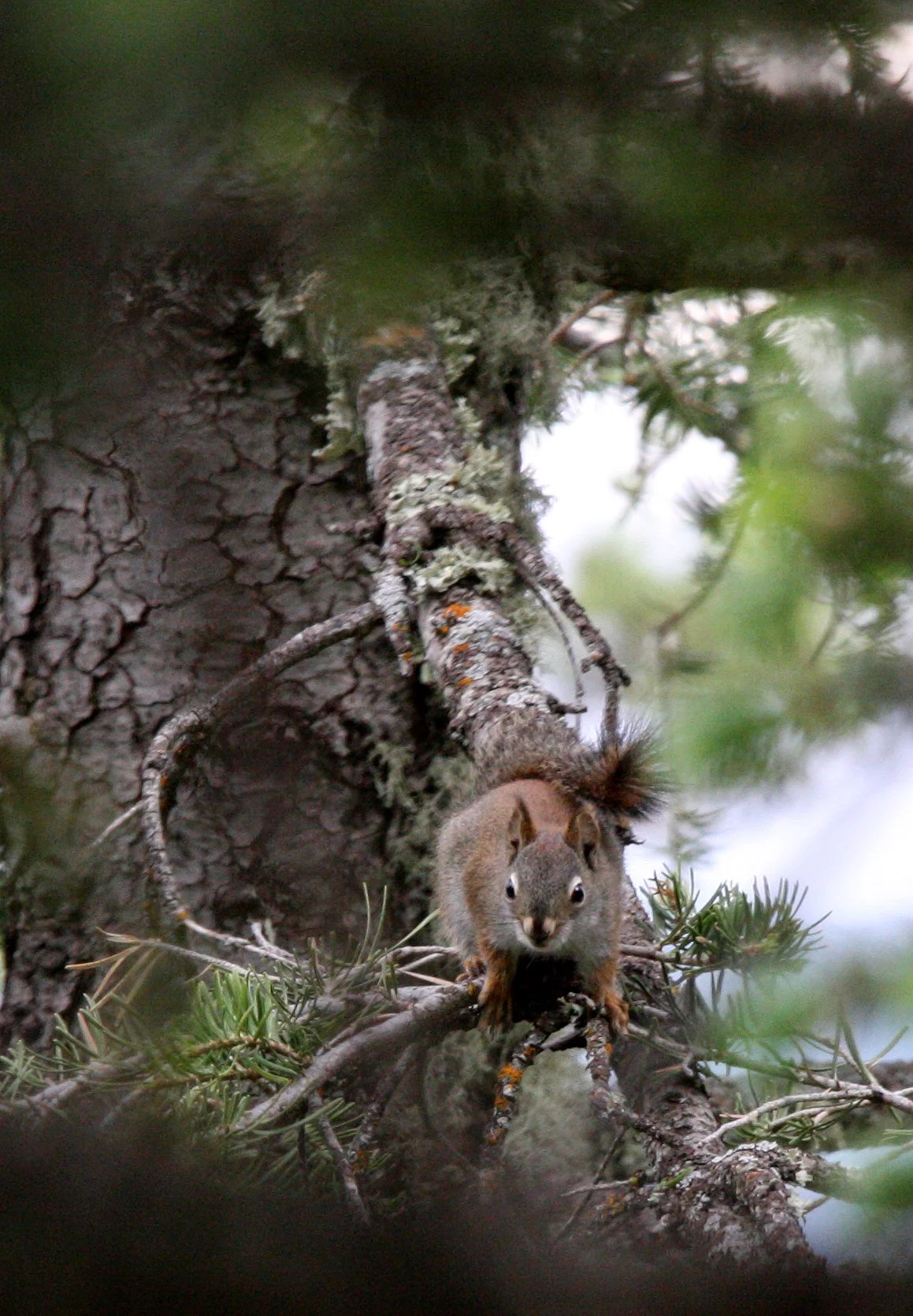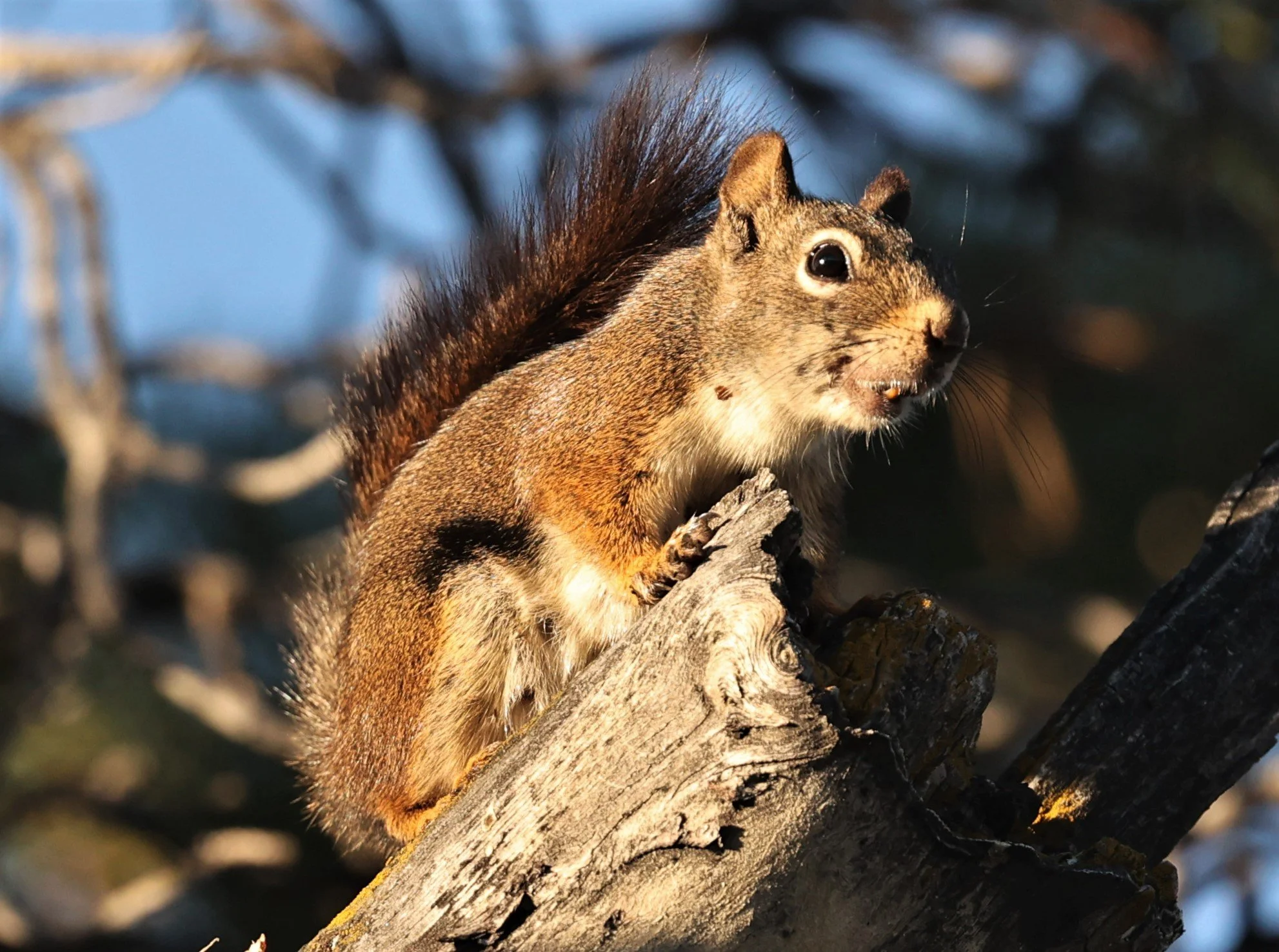
Genus Tamiasciurus, the Pine Squirrels

Pine squirrels, Tamiasciurus species, are small tree squirrels with bushy tails. Along with members of the genus Sciurus, they are members of the Sciurini tribe. The American red squirrel should not be confused with the Eurasian Red squirrel (Sciurus vulgaris) — both are usually just referred to as the "red squirrel" in their home continents. This gallery has sections with several subspecies of the species listed below. All subspecies were determined using the map functions of Encyclopedia of Life (EOL).
This page has galleries of the following species:
Douglas Squirrel (Tamiasciurus douglasii)
American Red Squirrel (Tamiasciurus hudsonicus)
Douglas squirrel (Tamiasciurus douglasii)
The Douglas squirrel (Tamiasciurus douglasii) is a pine squirrel found in the Pacific Northwest of North America, including the northwestern coastal states of the United States as well as the southwestern coast of British Columbia in Canada, with an isolated subspecies in northern Baja California. It is sometimes known as the chickaree or pine squirrel, although these names are also used for the American red squirrel. Variant spellings of the common name are Douglas' squirrel and Douglas's squirrel. The Native Americans of Kings River called it the "Pillillooeet", in imitation of its characteristic alarm call.
John Muir described the Douglas squirrel, Tamiasciurus douglasii, as "by far the most interesting and influential of the California Sciuridæ". Adults are about 33 cm in length (including its tail, which is about 13 cm long), and weigh between 150 and 300 grams. Their appearance varies according to the season. In the summer, they are greyish or almost greenish-brown on their backs, and pale orange on the chest and belly, while legs and feet appear brown. In the winter, the coat is browner and the underside is grayer; also, the ears appear even tuftier than they do in summer. Like many squirrels, Douglas squirrels have a white eye-ring.
Mating can occur as early as February. Gestation is about four weeks, and the young (which are altricial) are weaned at about eight weeks of age. There may be up to six kits in a litter, though four is more usual. In the southern and lower parts of their range, they produce two litters each year.
Douglas squirrels live in coniferous forest habitats along the Pacific Coast, from the Sierra Nevada (mountains) of California, northwards to the southwestern coast of British Columbia. Tamiasciurus douglasii prefer old-growth forests or mature second-growth forests, and some authors regard them as dependent on its presence. Mearns's squirrel is a distinctive subspecies of the Douglas squirrel that instead inhabits xeric pine forests in a small portion of Baja California.
Throughout most their range, Douglas squirrels essentially replace the American Red Squirrel, which inhabits the coniferous forests of the rest of North America, in these areas. The two species have very minimal overlap in the territory.
Douglas squirrels are territorial; in winter, each squirrel occupies a territory of about 10 000 square metres, but during the breeding season a mated pair will defend a single territory together. Douglas squirrels are active by day, throughout the year, often chattering noisily at intruders. On summer nights, they sleep in ball-shaped nests that they make in the trees, but in the winter they use holes in trees as nests. Groups of squirrels seen together during the summer are likely to be juveniles from a single litter.
Douglas Squirrel (Tamiasciurus douglasii douglasii) - Coastal California to Olympic Peninsula Washington






























Douglas Squirrel (Tamiasciurus douglasii mollipilosus) - Northern California and Cascades to Sierra Mountains












American red squirrel (Tamiasciurus hudsonicus)
The American red squirrel (Tamiasciurus hudsonicus) is one of three species of tree squirrels currently classified in the genus Tamiasciurus, known as the pine squirrels (the others are the Douglas squirrel, T. douglasii, and the southwestern red squirrel, T. fremonti). The American red squirrel is variously known as the pine squirrel, North American red squirrel and chickaree. It is also referred to as Hudson's Bay squirrel, as in John James Audubon's work The Viviparous Quadrupeds of North America (hence the species name). The squirrel is a small, 200–250 g (7.1–8.8 oz), diurnal mammal that defends a year-round exclusive territory. It feeds primarily on the seeds of conifer cones, and is widely distributed across North America wherever conifers are common, except on the Pacific coast of the United States, where its cousin, the Douglas squirrel, is found instead.
The squirrel has been expanding its range into hardwood forests.
American red squirrels should not be confused with Eurasian red squirrels (Sciurus vulgaris); since the ranges of these species do not overlap, they are both commonly referred to as "red squirrels" in the areas where they are native. The specific epithet hudsonicus refers to Hudson Bay, Canada, where the species was first catalogued by Erxleben in 1771. A recent phylogeny suggests the squirrels as a family can be divided into five major lineages. Red squirrels (Tamiasciurus) fall within the clade that includes flying squirrels and other tree squirrels (e.g., Sciurus). There are 25 recognized subspecies of red squirrels.
The southwestern red squirrel (T. fremonti) was long considered conspecific with T. hudsonicus, but a 2016 phylogenetic study found it to be a distinct species.
Red squirrels can be easily distinguished from other North American tree squirrels by their smaller size, 28–35 cm (11–14 in) total length (including tail), territorial behavior, and reddish fur with a white venter (underbelly).[6] Red squirrels are somewhat larger than chipmunks.
The Douglas squirrel is morphologically similar to the American red squirrels, but has a rust-colored venter and is restricted to the southwestern coast of British Columbia and in the Pacific Northwest of the United States. The ranges of the American red squirrel and the Douglas squirrel overlap in southern British Columbia, northwestern Washington and eastern Oregon.
American red squirrels are widely distributed across the North American continent. Their range includes: most of Canada, excluding northern areas with no tree cover, the southern half of Alberta and the southwestern coast of British Columbia; the southern half of Alaska; the Rocky Mountains area of the United States, and northern half of the eastern United States. American red squirrels are abundant and not of conservation concern throughout much of their range. American red squirrels were introduced on Newfoundland and have lived there in abundance for decades. However, an isolated population of red squirrels in Arizona has experienced considerable declines in population size. In 1987, this portion of the population was listed as an endangered species.
Fremont’s American Red Squirrel (Tamiasciurus hudsonicus fremonti) - Western States





Vancouver Island Red Squirrel (Tamiasciurus hudsonicus lanuginosus) - Vancouver Island Mount Washington Sky Area










Sacramento Mountains Red Squirrel (Tamiasciurus hudsonicus lychnuchus) - Sacramento Mountains, New Mexico











American Red Squirrel (Tamiasciurus hudsonicus streatori) - Eastern Washington, Potholes State Park






American Red Squirrel (Tamiasciurus hudsonicus ventorum) - Craters of the Moon & Yellowstone National Park






















